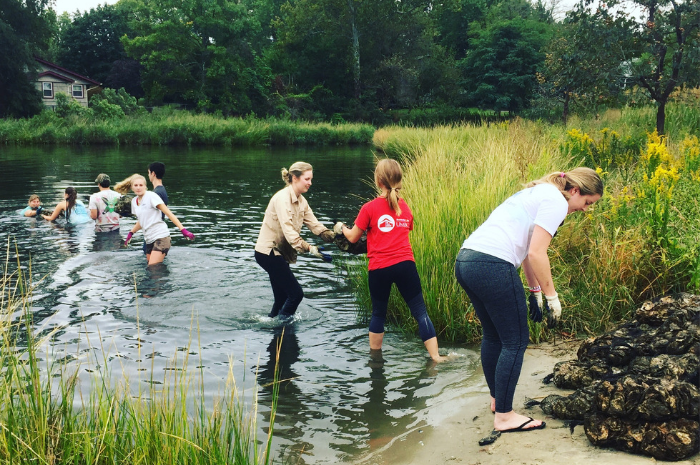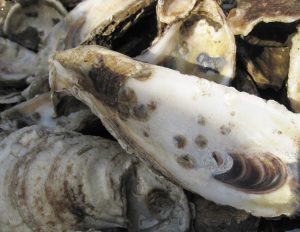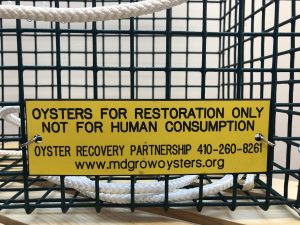
How does the MGO Program work?
MGO is an annual volunteer oyster growing effort that takes place in 30+ Chesapeake and coastal Bay tributaries. The program’s goal is to educate the public about how oysters affect the Chesapeake’s health and it is a hands-on way to engage the public in Bay recovery efforts. ORP manages the program and works with a network of volunteer tributary coordinators and homeowners (aka “growers”) from tributaries that have salinity levels high enough to support oyster growth. Each participating tributary has a volunteer coordinator who serves as growers’ main point of contact, and who makes important decisions like when to plant, what supplies are needed, etc. The timeline for the program is roughly as follows – your local coordinator will share specific details.
- May – July: Oysters collected and planted on sanctuary reefs.
- August – October: New batches of oysters and cages delivered to your community.
- October – May: Oysters growing in water.
How do I get started with MGO?
To sign up for the MGO program, read the Getting Started page and fill out the signup form. An ORP team member will reply and put you in contact with the nearest tributary coordinator.
What do I do with my cages in the winter?
Oysters will die when exposed to frigid winter temperatures, so it’s important to adjust the cage line to lower your cages until they are fully submerged just above the creek bottom. Your oysters will survive as long as they are underwater.
Do I need to feed my oysters?
No. Oysters eat algae and the Bay provides it for them.
I can’t see any juvenile oysters, aka spat? Did I get blank shells?

Four-month-old spat-on-shell.
Oyster spat are very small – the size of a single coffee ground – and may not be visible at first. Give them time to grow and they will be easier to see. If months go by and you still don’t see any spat, then let your coordinator know.
What if my oyster cage becomes heavily fouled?
The accumulation of fouling organisms (similar to what grows on your pilings) is normal but can become a nuisance by making your cages heavy. Keep cages clean by regularly dipping them in the water like a tea bag, scrubbing them with a brush (no detergent or soap), or hosing them down.
Will the fouling growth hurt the spat?
No, fouling growth won’t hurt the spat. It will simply make the cage heavier. As long as the cage’s wire mesh is at least 50% open for water flow, the oysters will receive plenty of water. Please avoid any concern by regularly tending to cages.
When will the oysters be collected?
The oysters will be collected during May – June, about nine months after you receive them. This time period avoids the heavy fouling that would occur if you continued tending the cages through the summer.
Will the oysters I grow be moved away from my river or do they stay here?
For a few tributaries, your oysters will be moved to an adjacent river because there is no sanctuary in your river. If you are located in a creek off a river that doesn’t have an historic oyster bar, then your oysters will be moved to the main river for planting. Small creeks and coves rarely have suitable bottom for oysters.
Why are my spat growing so slowly?
Slow growth could be due to lack of food, silt, low salinity, or low temperatures. If the spat are stressed, they are less likely to grow. In warmer months, rinsing the cages often helps.
Can I eat the oysters I grow?
 No. MGO oysters are too small to harvest, and the program’s purpose is to plant them in sanctuaries where they will improve water quality and create habitat for other species. The oyster seafood industry is highly regulated and waters where oysters are harvested are carefully monitored to ensure that the seafood is safe for human consumption. The MGO program operates outside of these areas; the spat are not safe to consume.
No. MGO oysters are too small to harvest, and the program’s purpose is to plant them in sanctuaries where they will improve water quality and create habitat for other species. The oyster seafood industry is highly regulated and waters where oysters are harvested are carefully monitored to ensure that the seafood is safe for human consumption. The MGO program operates outside of these areas; the spat are not safe to consume.
What do I do if I can no longer care for the oysters and want them removed?
Please contact your tributary coordinator and ORP’s Marylanders Grow Oysters program manager: [email protected].
What if I have additional questions?
Please read through all MGO pages first. Still can’t find the info you need? Contact the MGO Program manager: [email protected].
